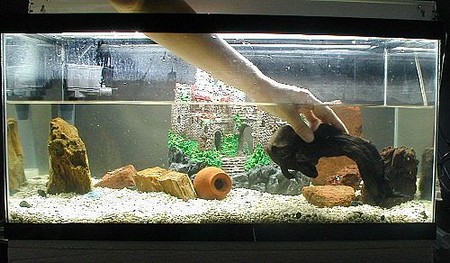Choosing healthy fish, providing them with good environmental conditions, and protecting them from undue stress are the keys to preventing unnecessary illness in your aquarium. It is also vital to spot and respond to any signs of disease or infection quickly, or the ailment may spread quickly to other fish in the tank.
How illness spreads
If you choose your stock well, and establish a good maintenance routine, you should find your fish remain generally healthy. Even the most experienced and attentive aquarist is bound to face some problems, however. Illness most often occurs with new arrivals, because the stress of the move tends to make them more vulnerable. Many fish carry bacteria and other microbes which normally cause them no ill-effects, but which may give problems when the fish are subjected to stress.
As well as watching your fish for pleasure, observe them at close quarters. Check that they are feeding properly, and appear healthy, with no unusual swellings or damage on their bodies. If you detect health problems at an early stage, it may well be possible to save the fish by simple treatment.
Prevention
To minimize potential problems, it is usually best to keep new acquisitions in a quarantine or isolation tank for at least two weeks, so you can check that they are feeding well and appear healthy. After this, you may transfer them to their permanent home. This initial settling-in stage can also be a potentially difficult period for the fish if they are introduced to an aquarium where other fish are already established. The newcomers may be regarded as intruders into this territory and may be harassed as a result. This may happen even in the case of fish that naturally form shoals, so watch them to make sure they are settling in well.
Initial precautions
It is always better to take precautions in the first place than to try to remedy problems once they occur:
- Check fish before you buy them, to reduce the risk of introducing illness to the aquarium.
- Discard the water in which you transported the fish, because it could contain potentially harmful microbes .
- Float the bag on the water in the new tank to equalize the temperatures. Fish are stressed by sudden changes in their conditions; if chilled, their immune system is less resistant to infections and fungus, especially if they are weak or if the scales or fins are damaged.
- Aquarium plants and substrate material may include hidden hazards, particularly parasites, so inspect plants carefully before adding them, and use an aquarium disinfectant to reduce the risk of infection.
- Once the fish are settled in, the greatest threat to their health, aside from poor water quality, comes from live foods of wild aquatic origin, which can introduce diseases and parasites to the tank.
The stress factor
Stress can be a major killer, especially when fish come into breeding condition. Watch for persistent bullying of weaker individuals at this time – if they do not get the chance to feed properly, they will become progressively weaker. Make sure the tank decor and planting allow fish the opportunity to find refuge when necessary. If you notice a particular fish being persecuted by a tankmate, one of the fish should be removed; it may be better to take out the dominant individual, reintroducing it at a later stage.
Care with chemicals
At times, you may encounter problems such as excess algae that you may want to tackle with chemicals. With any kind of chemical product, always follow the instructions strictly and only use a treatment recommended for aquarium use. Bear in mind that some products may have adverse side-effects on plants or fish, so check that the product will not cause them any harm. Certain plants, especially any that have been colonized by algae, may be harmed by the use of an algicide.

Where possible, tackle problems using non-chemical methods, because these have less impact on the balance of the tank ecosystem. For example, if you kill off all the algae at once with a chemical, this leads to <i reduction in water quality, to the extent that the filter may not be able to cope effectively. Some fish and snails browse on algae, helping to keep it in check. Take out the tank decor and treat it separately, to reduce stress on the fish. Look for potential causes of the problem, too, so you can prevent a recurrence: Excess algae often results from too much light, high nitrate levels, and is more likely in a tank without plants. If your plants are being eaten because the tank contains too many snails, you may be tempted to kill the snails with a molluscicide. Even after using a treatment of this kind, you will still need to collect them up, otherwise the water quality will deteriorate rapidly as they decompose. A better course of action is to remove the snails by hand or to net them, and to destroy the snail eggs as they are laid to prevent future problems.
